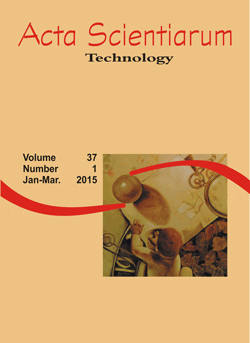<b>Yield from photovoltaic modules under real working situations in west Paraná - Brazil
DOI:
https://doi.org/10.4025/actascitechnol.v37i1.19191Keywords:
solar irradiance, temperature, deposited dust, positioningAbstract
This study analyzed the external factors that influence the yield obtained from photovoltaic modules (Solarex® - MSX 56), as solar irradiance, temperature, placement angle and dust deposition on the photovoltaic modules installed at the facilities of the Medianeira campus of the UTFPR, working under real conditions. To obtain the data it was used a datalogger from Campbell Scientific, Inc, model CR23X. It was observed that under solar irradiance below 550 W m-2 the panel did not convert maximum power, and above this value the panel reached saturation levels. Temperature increase led to reduced voltage, and consequently lower module output power, decreasing the efficiency value by nearly 6% at temperatures 15oC above the Standard Test Conditions (STC) temperature. These panels are usually placed at different angles according to local latitude, remaining fixed in that position. In comparison with a horizontally-placed panel, it was obtained a 4-hour increase in yield when the panel reached saturation value. Dust levels reduced electricity production levels by approximately 16%. These factors must be taken into account for placement and maintenance of photovoltaic systems, so they can function efficiently.
Â
Downloads
Downloads
Additional Files
Published
How to Cite
Issue
Section
License
DECLARATION OF ORIGINALITY AND COPYRIGHTS
I Declare that current article is original and has not been submitted for publication, in part or in whole, to any other national or international journal.
The copyrights belong exclusively to the authors. Published content is licensed under Creative Commons Attribution 4.0 (CC BY 4.0) guidelines, which allows sharing (copy and distribution of the material in any medium or format) and adaptation (remix, transform, and build upon the material) for any purpose, even commercially, under the terms of attribution.
Read this link for further information on how to use CC BY 4.0 properly.











8.png)




